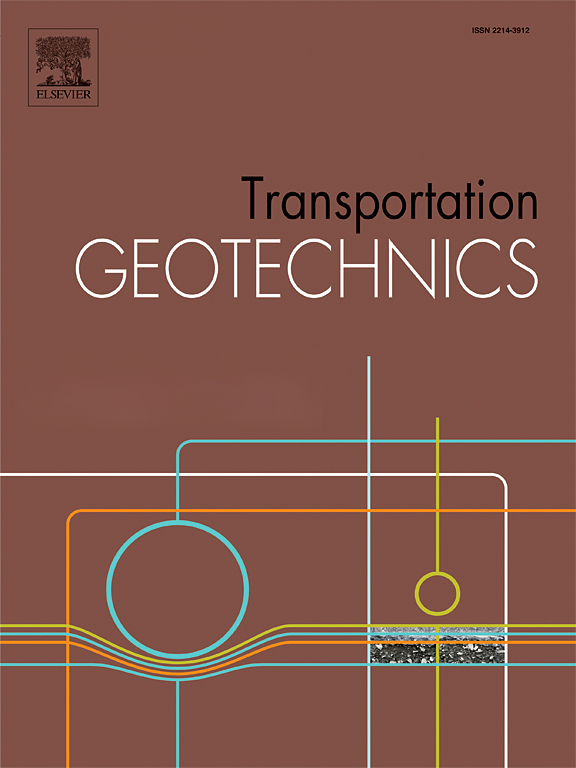高速列车动荷载作用下膨胀性地层中隧道的动态响应和长期损伤演变
IF 4.9
2区 工程技术
Q1 ENGINEERING, CIVIL
引用次数: 0
摘要
高速列车的动荷载和周围土壤的膨胀压力共同作用,往往会导致隧道结构在使用期间发生破坏。本研究对膨胀土进行了一系列膨胀压力、膨胀率和剪切强度试验,以分析初始含水量和干密度对膨胀行为的影响。结果表明,膨胀压力与初始含水量(干密度)呈负(正)相关。膨胀率随垂直压力和初始含水量的增加而降低。膨胀土的抗剪强度、内摩擦角和内聚力与初始含水量呈近似线性负相关。为研究隧道的动态响应和长期破坏演变,建立了一个结合列车动荷载、周围土壤和衬砌结构的三维动态计算模型。模拟结果表明,在高速列车动荷载和膨胀压力的共同作用下,隧道的最大垂直加速度和垂直位移响应发生在反演中心。与此相反,最小主应力响应的最大峰值出现在轨道下方的倾角附近。加速度、垂直位移和最小主应力的最小响应峰值分别出现在顶板、斜面和墙壁处。隧道的垂直加速度、垂直位移和最小主应力峰值与膨胀压力(或列车速度)呈正相关。当列车速度低于 300 公里/小时时,膨胀压力(或列车速度)的变化不会改变每个测量点的响应包络图形状或响应的相对强度。隧道上部结构(墙壁以上)几乎没有受到破坏,主要集中在隧道的反面和两侧坡脚。拉伸破坏大于压缩破坏,在隧道使用的头 15 年中,膨胀压力对隧道的破坏发展速度有很大影响。本文章由计算机程序翻译,如有差异,请以英文原文为准。
Dynamic responses and long-term damage evolution of tunnels in expansive strata under dynamic loads from high-speed trains
The combined effects of dynamic loads from high-speed trains and surrounding soil expansion pressure often lead to structure failure in tunnels during their service period. This study conducts a series of expansion pressure, expansion rate, and shear strength tests on expansive soil to analyze the impact of the initial moisture content and dry density on expansion behaviors. The results indicate that the expansion pressure is negatively (positively) correlated with the initial moisture content (dry density). The expansion rate decreases with increasing vertical pressure and initial moisture content. The expansive soil’s shear strength, internal friction angle, and cohesion are approximately linearly negatively correlated with initial moisture content. A three-dimensional dynamic computational model combining the train dynamic load, surrounding soil, and lining structure is established to study the tunnel’s dynamic responses and long-term damage evolution. The simulation results indicate that the combined effects of high-speed train dynamic loads and expansion pressure cause the tunnel’s maximum vertical acceleration and vertical displacement response to occur at the center of the invert. In contrast, the maximum peak of the minimum principal stress response occurs near the invert beneath the track. The minimum responses of the acceleration, vertical displacement, and peak of the minimum principal stress occur at the roof, hance, and wall, respectively. The tunnel’s vertical acceleration, vertical displacement, and peak minimum principal stress are positively correlated with expansion pressure (or train speed). When the train speed is below 300 km/h, changes in the expansion pressure (or train speed) do not alter the shape of the response envelope diagram or the relative intensity of the response at each measuring point. The upper structure of the tunnel (above the wall) experiences little damage, which is concentrated primarily in the invert and both side feet of the tunnel. Tensile damage is greater than compression damage, and the expansion pressure significantly affects the rate of damage development in tunnels during the first 15 years of service.
求助全文
通过发布文献求助,成功后即可免费获取论文全文。
去求助
来源期刊

Transportation Geotechnics
Social Sciences-Transportation
CiteScore
8.10
自引率
11.30%
发文量
194
审稿时长
51 days
期刊介绍:
Transportation Geotechnics is a journal dedicated to publishing high-quality, theoretical, and applied papers that cover all facets of geotechnics for transportation infrastructure such as roads, highways, railways, underground railways, airfields, and waterways. The journal places a special emphasis on case studies that present original work relevant to the sustainable construction of transportation infrastructure. The scope of topics it addresses includes the geotechnical properties of geomaterials for sustainable and rational design and construction, the behavior of compacted and stabilized geomaterials, the use of geosynthetics and reinforcement in constructed layers and interlayers, ground improvement and slope stability for transportation infrastructures, compaction technology and management, maintenance technology, the impact of climate, embankments for highways and high-speed trains, transition zones, dredging, underwater geotechnics for infrastructure purposes, and the modeling of multi-layered structures and supporting ground under dynamic and repeated loads.
 求助内容:
求助内容: 应助结果提醒方式:
应助结果提醒方式:


